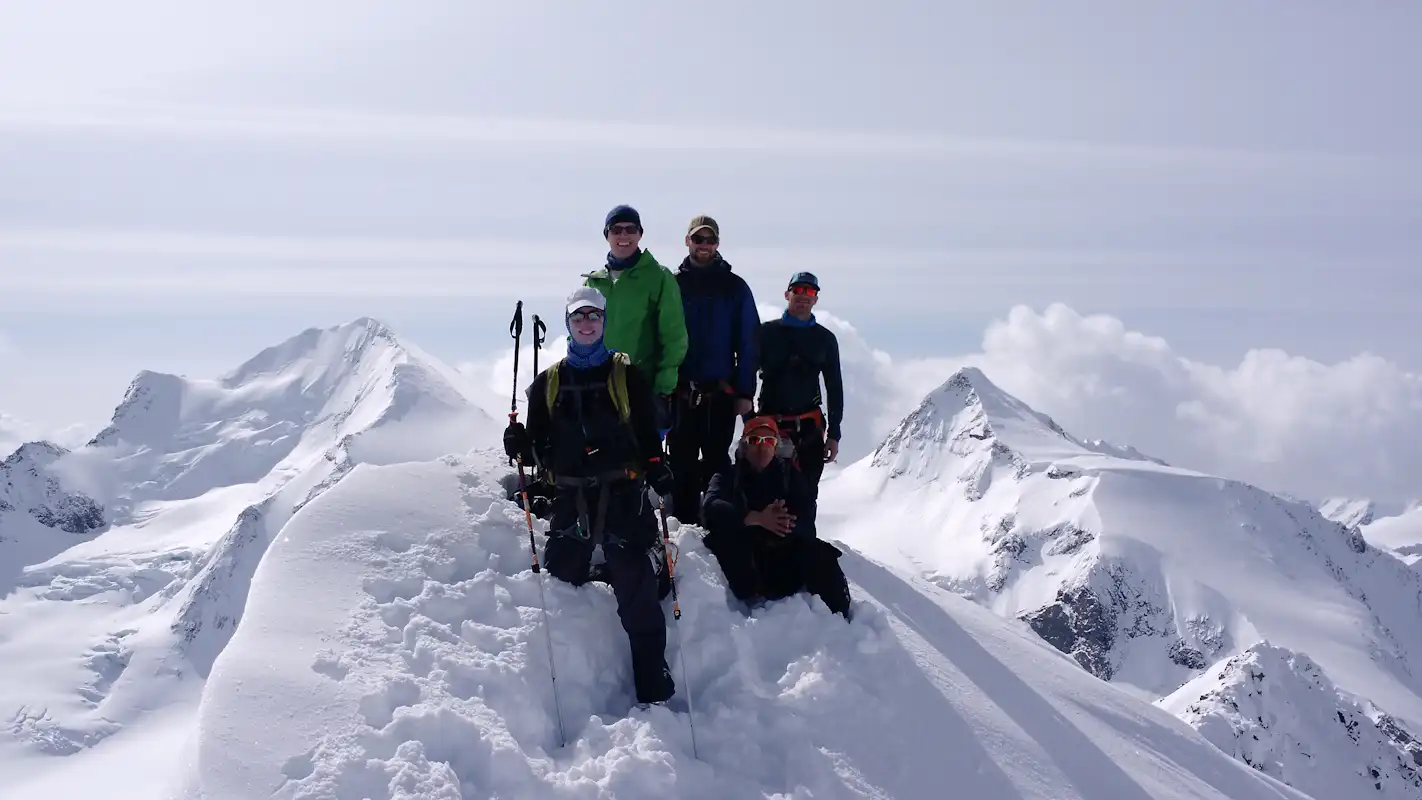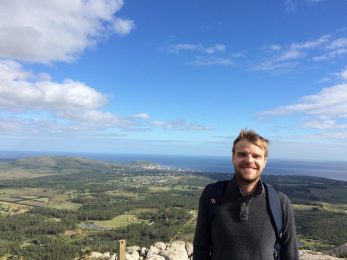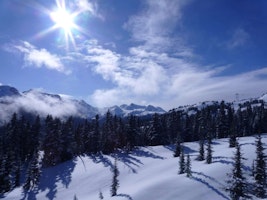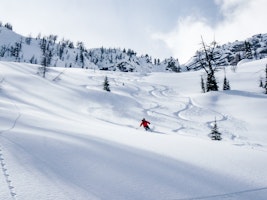Located in the southwest of Alberta, about an hour and a half away from Calgary, Banff National Park is one of Canada’s top backcountry skiing destinations.
It gets this reputation because of its remote location along the continental divide of North America in the front range of the Canadian Rocky Mountains. Once you’ve left the road and gone out into the backcountry, you are unlikely to find another soul.
It is also an incredibly scenic part of the world, boasting a whole array of diverse landscapes from 3.400-plus meter high mountains to massive glaciers and ice fields. It is definitely the ideal place to come and unplug from the busy modern world for awhile.
Hut-to-hut treks are particularly popular here, for just this reason. They let you get out and see a lot of the park’s diverse landscapes. Single-day trips in particular spots are also quite popular. They let you get some great backcountry skiing in and are a more economic option for people skiing on a budget.
Jeff Bullock is an AMGC-certified mountain guide and has been skiing in the Banff backcountry for the past 24 years. He recently spoke with Explore & Share to share some of his insights and knowledge about the area.
To whet you appetite for your next ski holiday here, we’ve taken the time to compile a list of top spots as well as some other useful information you’ll need to know before you book.
3 Reasons to Backcountry Ski in Banff National Park
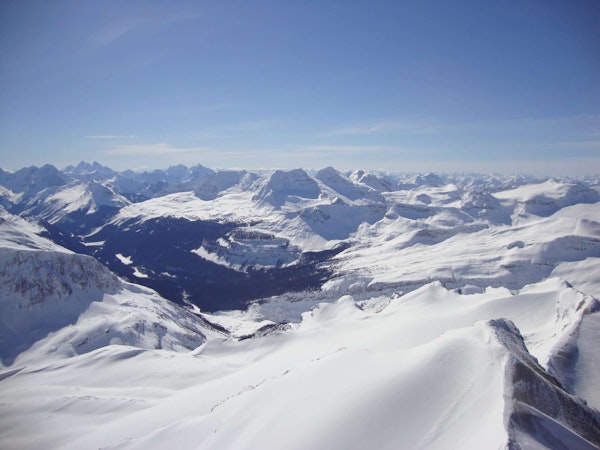
Stunning scenery
From the blue-hued, snow-capped mountains surrounding the Valley of Ten Peaks to the imposing figure cut by the Columbia Icefield, and everything in between, there is plenty to see in Banff.
Backcountry skiing takes you all around these mountains, as well as to the summit of several others, yielding fantastic views of the lakes and forests that are situated in the valleys in between.
"The rugged landscape of the Rockies, couloirs, mountain faces and vast ice fields makes backcountry skiing in Banff National Park a special experience," Jeff said.
Perfect powder
Banff National Park and its surroundings get plenty of snowfall. Heading out into the backcountry means plenty of it will be unspoiled by the time you arrive as well. This makes those long runs down uninterrupted slopes all the better.
Farther west in Yoho National Park, the snow tends to be even deeper. The snowpack can be double that of Banff, due to the rain shadow cast by the Rockies. Head out here, for unbeatably deep powder experiences.
The Bow-Yoho traverse lets you experience both Banff and Yoho National Parks.
Avoid the crowds
Nothing drags down a backcountry skiing holiday like waiting in line to go up a ski lift. That dreaded feeling is unimaginable in Banff National Park. The vast and remote stretches of this park mean you could ski all day and see no one else at all.
Backcountry skiing gets you away from the slightly more populated resorts and out into the wilderness. You’ll feel like you’re in a Jon Krakauer book as you head up isolated peaks only to get views of vast and unspoiled terrain below. Ski back down knowing that for now, you have this all to yourself.
"All back country activities are human powered," Jeff said. "Roads are limited and the back country is pristine."
Where are the Best Spots to Go?
1| Wapta Traverse
Beginning from the Icefields Parkway, the Wapta Traverse is one of backcountry skiers’ top itineraries in the region.
Over the course of this 45 kilometer trek, which is the only one in North America that compares with the classic French-Swiss Haute Route, you’ll cross the continental divide several times as you head from one stopping location to the next.
The trek starts with an ascent toward Peyto Hut, in an impressive glaciated valley. From here, you will ski south toward Bow Hut, finishing off the day with a long and impressive run to the door of the accommodation.
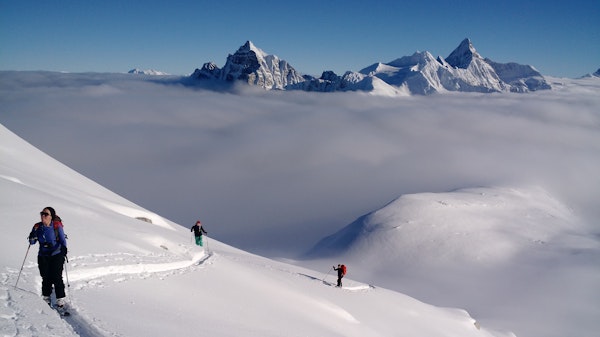
Along the way, you’ll have the option to climb Mount Rhondda South, which most people take as they are eager to get some views out over the impressive landscape.
From Bow Hut, you continue south to Balfour hut, heading over the col on the south-side of Mount Saint Nicholas. This part of the trek can be quite difficult as you avoid various crevasses while crossing the Vulture Glacier.
The next day, you will climb from the hut over the High Col and cross the Wapta Glacier en route to the Scott Duncan Hut.
For Jeff, "the easily accessible remote ice fields" are the highlight of the entire trip.
The final day involves a long downhill run, which after all the uphill trekking is very enjoyable, to the Trans-Canada Highway. Along the way, expect great bits of skiing through alpine forests with stunning views.
In brief:
Area: Banff National Park and Yoho National Park, Alberta and British Columbia
Duration: 4 to 5 days, depending on the route where you start. Four day treks begin from Bow Hut.
Difficulty level: Intermediate to sustained
Top trips: Classic Wapta Traverse in 4 days
2| Lake Louise
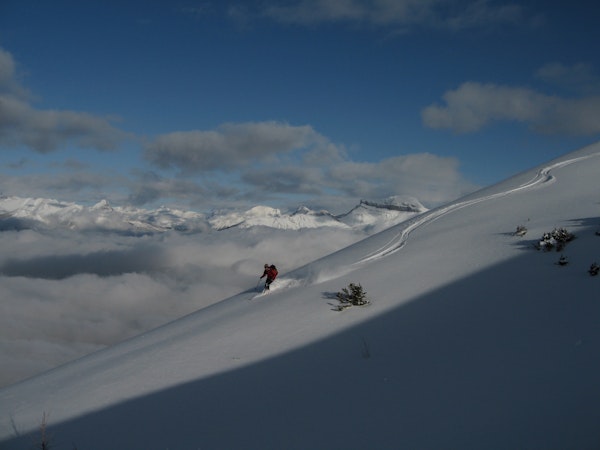
Renowned for its beauty, Lake Louise is one of the top single-day backcountry skiing spots in the entire region.
It was home to a few ski events in the 1988 Winter Olympics, which were held in Calgary, and narrowly lost out on three prior bids to host the event, itself.
The skiing here is sublime. With a combination of lifts, taking you up to mountain passes as well as the freedom to head out on your own either side of the valley, there is little that you can’t do here.
With numerous powder bowls and ridges in every direction, you can spend a whole day, weekend or week skiing something new. Among the many highlights are Purple Bowl, Pumpkin Bowl, Wolverine Ridge, the Corral paths and West bowl, all of which can be accessed with the assistance of lifts.
"Day trips from Lake Louise can allow for ski accents of 3400-plus meter high peaks with long glacier runs back to the road," Jeff said.
However, if you want to get farther away from these more populated slopes, there are several options for that as well.
Among the most popular are Surprise Ridge, which takes you around the beautiful Fairview mountain. You can also climb the peak, if you’re feeling up to the challenge, and enjoy spectacular views from the top and even better runs down its flank.
The Surprise Pass route will also take you past the glaciated slopes of Mount Aberdeen, which provides another excellent climbing option.
Other popular destinations from the valley include Mount Victoria's summit, Cathedral Peak and Mount Field. You really can’t go wrong with picking any of them.
For backcountry skiers looking to keep their options open, Lake Louise is the place to head. Regardless of what you choose, there’s plenty of great skiing and picturesque scenery to be experienced and seen!
In brief:
Area: Banff National Park, Alberta
Duration: 1+ day, depending on the time you have to ski
Difficulty level: Intermediate
Top trips: Backcountry riding in Lake Louise area (5 days); Ski touring weekend in Lake Louise; Ski weekend in Lake Louise Alpine Center
3| Bow to Yoho Traverse (Alternative Wapta Traverse)
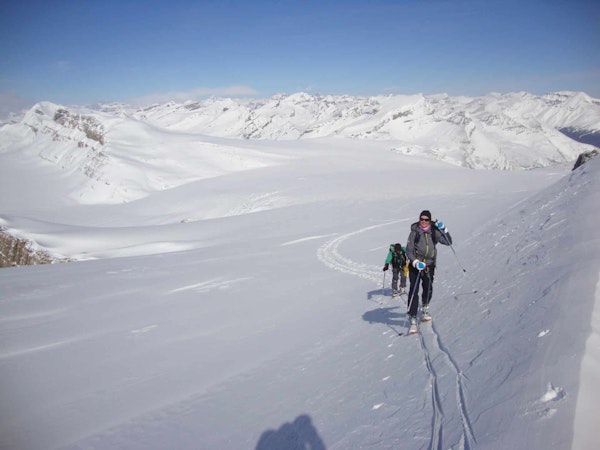
Dubbed by Canadian Rockies ski touring legend Chic Scott as “the quintessential Canadian Rockies skiing experience”, the Alternative Wapta Route is a bit of a twist on the traditional route.
Beginning at Bow Lake, you cut across its frozen surface and head up along the ridge between Mount Olive and Mount St. Nicholas, getting up to 2.300 meters above sea level before arriving in the evening at Bow hut.
From here, you head up onto the Wapta Glacier and travel across it in the shadows of Mt Rhonda and Mt Collie, before arriving at Louise and Richard Guy Hut. From here, you get great views out overlooking Mount des Poilus and the des Poilus glacier.
The third day is generally dedicated to exploring the area and here is where the itinerary gets more flexible. Many people head up to Mount des Poilus and enjoy the 500-meter descent from its upper flanks back down to the glacier.
However, there are other options too, depending on the weather conditions as well as your preferences.
The following day, you will head up onto the col of the next glacier, which gives you a great view of Little Yoho Valley as well as President and Vice President peaks. You will then ski all the way down into the valley and toward Mount Stanley Hut.
"The west end of the Bow-Yoho traverse offers some of the Rockies' best ski mountaineering," Jeff said.
Depending on the time you have, you can either spend time skiing on the slopes surrounding the Little Yoho Valley on the following day or head back to the road.
This last leg of the journey lasts for 25 kilometers and takes you along the Iceline then gradually down 760 meters to Emerald Lake. It’s a great way to conclude your trip, allowing you to take in the sights and finish on an easier note at yet another hidden gem.
In brief:
Area: Yoho National Park and Banff National Park, British Columbia and Alberta
Duration: 4 to 7 days, depending on how much time you have
Difficulty level: Intermediate to sustained
Top trips: Ski traverse in the Canadian Rockies, Bow Yoho
What is the Best Season to Go Backcountry Skiing?
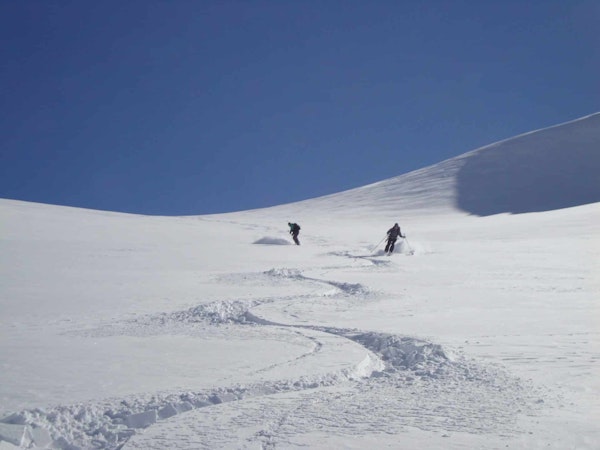
The best time to come backcountry skiing in Banff is from January to April. However, guides offer trips ranging from November all the way until May.
The aforementioned range is ideal because the days begin to warm up and get a bit longer. At the peak of winter, it gets dark by mid-afternoon.
When you come here in the winter, expect average daily temperatures of about -10ºC. In March and May these temperatures get a bit closer to freezing, but generally stay well below freezing.
It is also not uncommon for temperatures to fall well below -20ºC when you factor in wind chill. For this reason it is best to come prepared with multiple layers. Consult your guide for exact clothing recommendations.
During the winter months, Banff National Park gets a fairly consistent amount of snowfall each month. On the other side of the mountains, Yoho National Park receives even more, making the powder skiing there much deeper.
However, regardless of your destination, there will be plenty of snow throughout the season.
How Much Does a Guided Trip Cost?
The cost of a backcountry skiing trip to Banff National Park varies greatly, depending on how long you go for, how many people you go with, what you do and what is included.
However, for a four or five-day hut-to-hut traverse you can expect prices to start at about CAD $1.000 per person. This price is generally for a group of four to six. Expect to pay a few hundred more CAD for smaller groups.
This price also includes the guide fee, accommodation in mountain huts and group equipment. There are slightly cheaper trips offered that do not include the accommodation or group equipment, so they come out to about the same once you’ve factored these in.
For single-day ski trips to other parts of the park, prices start as low as CAD $200 per person and include the guide’s fee as well as group equipment.
Remember, every guide prices differently and includes different things in these prices. Be sure to check with your guide what is included in his or her price prior to confirmation of booking.
How to Get There?
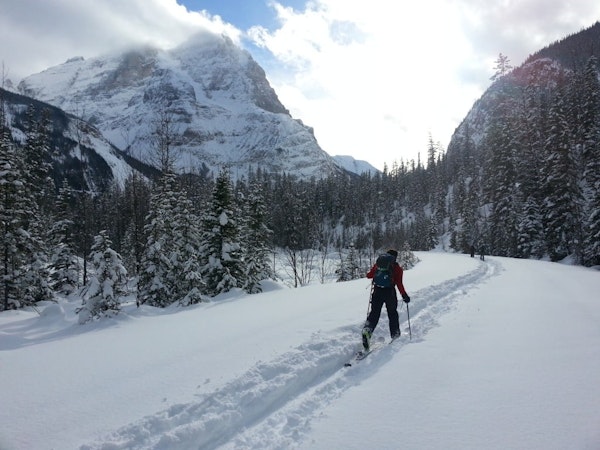
In spite of its remote location, getting to Banff National Park is not as difficult as you might think.
Any trip to the park will begin with a flight into the Calgary International Airport (YYC). The airport is pretty easily reached year-round from most major European, Asian and North American airports.
From here, there are shuttles that will take you directly to various spots in the park. You will likely be able to take one of these shuttles directly to the location at which you are meeting your guide.
Public shuttles are available on weekends and by far the cheapest option. On weekdays, you will have to book a private shuttle in advance, which costs a bit more.
Driving is also an option, but parking spaces in the park are limited. The drive is about 128 kilometers and, depending on weather conditions, takes about an hour and a half.
What Else Can you Do in Banff?
Before you head home after your backcountry skiing trip to Banff Louise, be sure to check out some of the other exhilarating outdoor sports that can be found in the National Park.
Ice climbing is another popular activity in the park, with many different options from beginner trips all the way up to advanced ones.
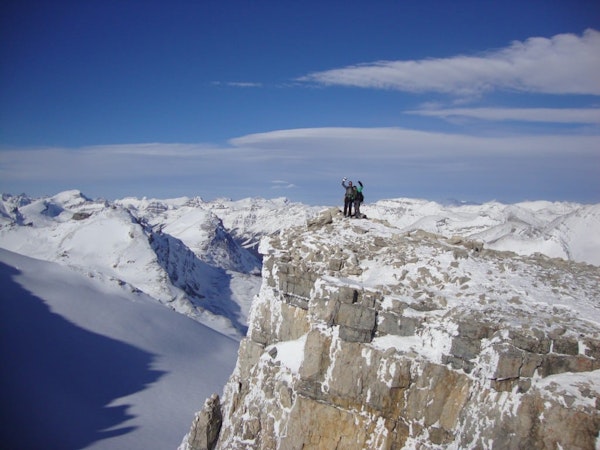
So what are you waiting for? Book your next backcountry skiing adventure today and get ready for a thoroughly exciting and stunningly scenic ski holiday in the wilderness of Banff National Park!
